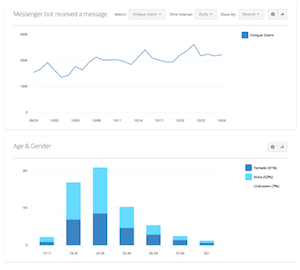 Facebook has announced the inclusion of analytics for bots in its Facebook Analytics for Apps dashboard which was first unveiled at the F8 conference in March of 2015. Now, in addition to the classic measures of audience demographics, as well as frequency and reach of messages, chatbot developers can derive additional, valuable insights into chatbot based activity, in order to detect which bots are being blocked and which generate the most interactions and, therefore, engagement.
Facebook has announced the inclusion of analytics for bots in its Facebook Analytics for Apps dashboard which was first unveiled at the F8 conference in March of 2015. Now, in addition to the classic measures of audience demographics, as well as frequency and reach of messages, chatbot developers can derive additional, valuable insights into chatbot based activity, in order to detect which bots are being blocked and which generate the most interactions and, therefore, engagement.
According to a Messenger blog post, the dashboard also provides aggregated and anonymized data on the types of users who are engaging with their bot. This data includes demographic insights about users’ age, gender, interests, country, and language. To dig deeper into how users are connecting with a chatbot, developers can leverage Facebook’s App Events API. This API automatically logs events such as received messages and blocked apps, but developers can also track their own custom events, including how many message-based conversations transfer from the chatbot to a human agent, how many users click on an offered link and “conversion rates” as users make purchases on the company’s website after conversing with a chatbot.
The integration of bot events into its analytics dashboard is one more sign that Facebook is making headway in transforming Messenger into a platform for text-based self-service and digital commerce. There should be concern that these key pieces of user data and metadata are under Facebook’s control and revealed exclusively through its analytic tools and APIs. Yet Facebook deserves credit for providing the foundation for brands to create better bots.
Today marketing and digital commerce professionals can tweak their bot offerings in response to key performance indicators reflected in analytic reports. It won’t be long before such changes can be made programmatically and more directly in response to actions by users. As a result, the bot-based experience should get more engaging and effective for individual users.
But long-term refinements start with modest additions to the the developer’s analytics toolkit. With the new additions, brands now have an integrated picture of how customers are engaging with their apps, bots, and websites. They can see what’s working and what’s not. Since most brands are still experimenting with bots to understand their potential value, access to insightful analytics is a huge plus.
Categories: Conversational Intelligence, Intelligent Assistants

 Talk to the Web: How NLWeb Opens Conversational Access to Site Content
Talk to the Web: How NLWeb Opens Conversational Access to Site Content  Voice AI Agents Redefine CX: Trends, ROI, and Strategies for 2025
Voice AI Agents Redefine CX: Trends, ROI, and Strategies for 2025  Why Voice AI Is Foundational for Enterprise Innovation (Webinar)
Why Voice AI Is Foundational for Enterprise Innovation (Webinar)  Zendesk Relate: Getting the Job Done with a Resolution Platform
Zendesk Relate: Getting the Job Done with a Resolution Platform